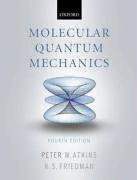
Molecular quantum mechanics PDF
Preview Molecular quantum mechanics
MOLECULAR QUANTUM MECHANICS, FOURTH EDITION Peter Atkins Ronald Friedman OXFORD UNIVERSITY PRESS MOLECULAR QUANTUM MECHANICS This page intentionally left blank MOLECULAR QUANTUM MECHANICS FOURTH EDITION Peter Atkins University of Oxford Ronald Friedman Indiana Purdue Fort Wayne AC AC GreatClarendonStreet,OxfordOX26DP OxfordUniversityPressisadepartmentoftheUniversityofOxford. ItfurtherstheUniversity’sobjectiveofexcellenceinresearch,scholarship, andeducationbypublishingworldwidein Oxford NewYork Auckland Bangkok BuenosAires CapeTown Chennai DaresSalaam Delhi HongKong Istanbul Karachi Kolkata KualaLumpur Madrid Melbourne MexicoCity Mumbai Nairobi Sa˜oPaulo Shanghai Taipei Tokyo Toronto OxfordisaregisteredtrademarkofOxfordUniversityPress intheUKandincertainothercountries PublishedintheUnitedStates byOxfordUniversityPressInc.,NewYork #PeterAtkinsandRonaldFriedman2005 Themoralrightsoftheauthorshavebeenasserted. DatabaserightOxfordUniversityPress(maker) Firstpublished2005 Allrightsreserved.Nopartofthispublicationmaybereproduced, storedinaretrievalsystem,ortransmitted,inanyformorbyanymeans, withoutthepriorpermissioninwritingofOxfordUniversityPress, orasexpresslypermittedbylaw,orundertermsagreedwiththeappropriate reprographicsrightsorganization.Enquiriesconcerningreproduction outsidethescopeoftheaboveshouldbesenttotheRightsDepartment, OxfordUniversityPress,attheaddressabove Youmustnotcirculatethisbookinanyotherbindingorcover andyoumustimposethissameconditiononanyacquirer BritishLibraryCataloguinginPublicationData Dataavailable LibraryofCongressCataloginginPublicationData Dataavailable ISBN0--19--927498--3 10 9 8 7 6 5 4 3 2 1 TypesetbyNewgenImagingSystems(P)Ltd.,Chennai,India PrintedinGreatBritain onacid-freepaperbyAshfordColourPress Table of contents Preface xiii Introductionandorientation 1 1 Thefoundationsofquantummechanics 9 2 Linearmotionandtheharmonicoscillator 43 3 Rotationalmotionandthehydrogenatom 71 4 Angularmomentum 98 5 Grouptheory 122 6 Techniquesofapproximation 168 7 Atomicspectraandatomicstructure 207 8 Anintroductiontomolecularstructure 249 9 Thecalculationofelectronicstructure 287 10 Molecularrotationsandvibrations 342 11 Molecularelectronictransitions 382 12 Theelectricpropertiesofmolecules 407 13 Themagneticpropertiesofmolecules 436 14 Scatteringtheory 473 Furtherinformation 513 Furtherreading 553 Appendix1Charactertablesanddirectproducts 557 Appendix2Vectorcouplingcoefficients 562 Answerstoselectedproblems 563 Index 565 This page intentionally left blank Detailed Contents Introductionandorientation 1 TheplausibilityoftheSchro¨dingerequation 36 1.22 Thepropagationoflight 36 0.1 Black-bodyradiation 1 1.23 Thepropagationofparticles 38 0.2 Heatcapacities 3 1.24 Thetransitiontoquantummechanics 39 0.3 ThephotoelectricandComptoneffects 4 PROBLEMS 40 0.4 Atomicspectra 5 0.5 Thedualityofmatter 6 2 Linearmotionandtheharmonic PROBLEMS 8 oscillator 43 1 Thefoundationsofquantummechanics 9 Thecharacteristicsofacceptablewavefunctions 43 SomegeneralremarksontheSchro¨dingerequation 44 Operatorsinquantummechanics 9 2.1 Thecurvatureofthewavefunction 45 1.1 Linearoperators 10 2.2 Qualitativesolutions 45 1.2 Eigenfunctionsandeigenvalues 10 2.3 Theemergenceofquantization 46 1.3 Representations 12 2.4 Penetrationintonon-classicalregions 46 1.4 Commutationandnon-commutation 13 Translationalmotion 47 1.5 Theconstructionofoperators 14 2.5 Energyandmomentum 48 1.6 Integralsoveroperators 15 2.6 Thesignificanceofthecoefficients 48 1.7 Diracbracketnotation 16 2.7 Thefluxdensity 49 1.8 Hermitianoperators 17 2.8 Wavepackets 50 Thepostulatesofquantummechanics 19 Penetrationintoandthroughbarriers 51 1.9 Statesandwavefunctions 19 2.9 Aninfinitelythickpotentialwall 51 1.10 Thefundamentalprescription 20 2.10 Abarrieroffinitewidth 52 1.11 Theoutcomeofmeasurements 20 2.11 TheEckartpotentialbarrier 54 1.12 Theinterpretationofthewavefunction 22 1.13 Theequationforthewavefunction 23 Particleinabox 55 1.14 TheseparationoftheSchro¨dingerequation 23 2.12 Thesolutions 56 2.13 Featuresofthesolutions 57 Thespecificationandevolutionofstates 25 2.14 Thetwo-dimensionalsquarewell 58 1.15 Simultaneousobservables 25 2.15 Degeneracy 59 1.16 Theuncertaintyprinciple 27 1.17 Consequencesoftheuncertaintyprinciple 29 Theharmonicoscillator 60 1.18 Theuncertaintyinenergyandtime 30 2.16 Thesolutions 61 1.19 Time-evolutionandconservationlaws 30 2.17 Propertiesofthesolutions 63 2.18 Theclassicallimit 65 Matricesinquantummechanics 32 1.20 Matrixelements 32 Translationrevisited:Thescatteringmatrix 66 1.21 Thediagonalizationofthehamiltonian 34 PROBLEMS 68 viii j CONTENTS 3 Rotationalmotionandthehydrogenatom 71 Theangularmomentaofcompositesystems 112 4.9 Thespecificationofcoupledstates 112 Particleonaring 71 4.10 Thepermittedvaluesofthetotalangular momentum 113 3.1 ThehamiltonianandtheSchro¨dinger equation 71 4.11 Thevectormodelofcoupledangular momenta 115 3.2 Theangularmomentum 73 4.12 Therelationbetweenschemes 117 3.3 Theshapesofthewavefunctions 74 4.13 Thecouplingofseveralangularmomenta 119 3.4 Theclassicallimit 76 PROBLEMS 120 Particleonasphere 76 3.5 TheSchro¨dingerequationand 5 Grouptheory 122 itssolution 76 3.6 Theangularmomentumoftheparticle 79 Thesymmetriesofobjects 122 3.7 Propertiesofthesolutions 81 5.1 Symmetryoperationsandelements 123 3.8 Therigidrotor 82 5.2 Theclassificationofmolecules 124 MotioninaCoulombicfield 84 Thecalculusofsymmetry 129 3.9 TheSchro¨dingerequationfor hydrogenicatoms 84 5.3 Thedefinitionofagroup 129 3.10 Theseparationoftherelativecoordinates 85 5.4 Groupmultiplicationtables 130 3.11 TheradialSchro¨dingerequation 85 5.5 Matrixrepresentations 131 3.12 Probabilitiesandtheradial 5.6 Thepropertiesofmatrixrepresentations 135 distributionfunction 90 5.7 Thecharactersofrepresentations 137 3.13 Atomicorbitals 91 5.8 Charactersandclasses 138 3.14 Thedegeneracyofhydrogenicatoms 94 5.9 Irreduciblerepresentations 139 PROBLEMS 96 5.10 Thegreatandlittleorthogonalitytheorems 142 Reducedrepresentations 145 5.11 Thereductionofrepresentations 146 4 Angularmomentum 98 5.12 Symmetry-adaptedbases 147 Thesymmetrypropertiesoffunctions 151 Theangularmomentumoperators 98 5.13 Thetransformationofp-orbitals 151 4.1 Theoperatorsandtheircommutation relations 99 5.14 Thedecompositionofdirect-productbases 152 4.2 Angularmomentumobservables 101 5.15 Direct-productgroups 155 4.3 Theshiftoperators 101 5.16 Vanishingintegrals 157 5.17 Symmetryanddegeneracy 159 Thedefinitionofthestates 102 4.4 Theeffectoftheshiftoperators 102 Thefullrotationgroup 161 4.5 Theeigenvaluesoftheangularmomentum 104 5.18 Thegeneratorsofrotations 161 4.6 Thematrixelementsoftheangular 5.19 Therepresentationofthefullrotationgroup 162 momentum 106 5.20 Coupledangularmomenta 164 4.7 Theangularmomentumeigenfunctions 108 Applications 165 4.8 Spin 110 PROBLEMS 166 CONTENTS j ix 6 Techniquesofapproximation 168 7.10 Thespectrumofhelium 224 7.11 ThePauliprinciple 225 Time-independentperturbationtheory 168 Many-electronatoms 229 6.1 Perturbationofatwo-levelsystem 169 7.12 Penetrationandshielding 229 6.2 Many-levelsystems 171 7.13 Periodicity 231 6.3 Thefirst-ordercorrectiontotheenergy 172 7.14 Slateratomicorbitals 233 6.4 Thefirst-ordercorrectiontothewavefunction 174 7.15 Self-consistentfields 234 6.5 Thesecond-ordercorrectiontotheenergy 175 7.16 Termsymbolsandtransitionsof 6.6 Commentsontheperturbationexpressions 176 many-electronatoms 236 6.7 Theclosureapproximation 178 7.17 Hund’srulesandtherelativeenergiesofterms 239 6.8 Perturbationtheoryfordegeneratestates 180 7.18 Alternativecouplingschemes 240 Variationtheory 183 Atomsinexternalfields 242 6.9 TheRayleighratio 183 7.19 ThenormalZeemaneffect 242 6.10 TheRayleigh–Ritzmethod 185 7.20 TheanomalousZeemaneffect 243 7.21 TheStarkeffect 245 TheHellmann–Feynmantheorem 187 Time-dependentperturbationtheory 189 PROBLEMS 246 6.11 Thetime-dependentbehaviourofa two-levelsystem 189 6.12 TheRabiformula 192 8 Anintroductiontomolecularstructure 249 6.13 Many-levelsystems:thevariationofconstants 193 6.14 Theeffectofaslowlyswitchedconstant TheBorn–Oppenheimerapproximation 249 perturbation 195 8.1 Theformulationoftheapproximation 250 6.15 Theeffectofanoscillatingperturbation 197 8.2 Anapplication:thehydrogenmolecule–ion 251 6.16 Transitionratestocontinuumstates 199 Molecularorbitaltheory 253 6.17 TheEinsteintransitionprobabilities 200 6.18 Lifetimeandenergyuncertainty 203 8.3 Linearcombinationsofatomicorbitals 253 8.4 Thehydrogenmolecule 258 PROBLEMS 204 8.5 Configurationinteraction 259 7 Atomicspectraandatomicstructure 207 8.6 Diatomicmolecules 261 8.7 Heteronucleardiatomicmolecules 265 Thespectrumofatomichydrogen 207 Molecularorbitaltheoryofpolyatomic molecules 266 7.1 Theenergiesofthetransitions 208 7.2 Selectionrules 209 8.8 Symmetry-adaptedlinearcombinations 266 7.3 Orbitalandspinmagneticmoments 212 8.9 Conjugatedp-systems 269 7.4 Spin–orbitcoupling 214 8.10 Ligandfieldtheory 274 7.5 Thefine-structureofspectra 216 8.11 Furtheraspectsofligandfieldtheory 276 7.6 Termsymbolsandspectraldetails 217 Thebandtheoryofsolids 278 7.7 Thedetailedspectrumofhydrogen 218 8.12 Thetight-bindingapproximation 279 Thestructureofhelium 219 8.13 TheKronig–Penneymodel 281 7.8 Theheliumatom 219 8.14 Brillouinzones 284 7.9 Excitedstatesofhelium 222 PROBLEMS 285
